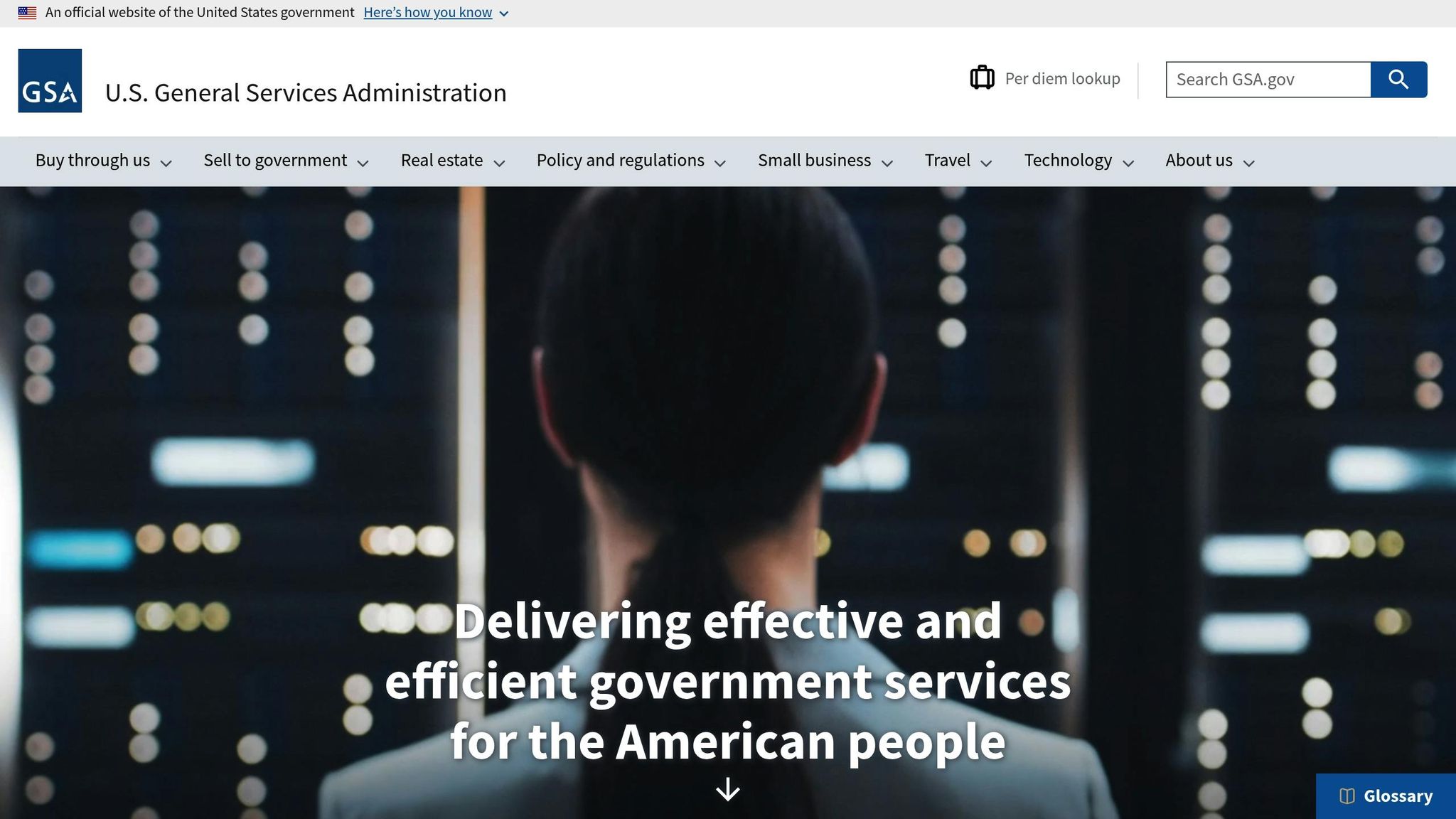Securing a GSA contract can open the door to federal markets worth $45 billion annually. Here’s the key takeaway: GSA uses a one-time pricing negotiation process to lock in fair and competitive rates for contractors and the government. Understanding this process is crucial for success.
Key Points:
- One-Time Pricing: GSA negotiates prices upfront, ensuring they meet "Fair and Reasonable" standards.
- Evaluation Criteria: Prices are assessed for market alignment, tiered pricing, compliance with Trade Agreements Act (TAA), and Most Favored Customer (MFC) terms.
- Preparation Tips: Research market trends, analyze competitors, and set clear price limits based on costs, volume, and contract duration.
- Common Pitfalls: Incomplete disclosures, pricing misalignment with benchmarks, and unjustified geographic variations can lead to closer scrutiny or penalties.
Why it matters: Businesses with GSA contracts report average yearly revenues of $927,000. Proper preparation and expert guidance can help you navigate this process and secure profitable contracts.
Read on to learn how to prepare, negotiate, and succeed in the GSA pricing process.
What Is GSA Pricing? – CountyOffice.org

The GSA Negotiation Process
The General Services Administration (GSA) uses a one-time negotiation process to establish pricing standards for contractors and the government. Knowing how this process works is essential for preparing a strong contract proposal. Here’s a closer look at the key elements of the process.
Steps in Price Negotiations
Once a business submits its proposal, negotiations focus on securing upfront pricing that complies with federal requirements. The goal is to strike a balance that works for both the contractor and the government.
Working with Contracting Officers
GSA Contracting Officers play a central role in this process. They manage and finalize pricing discussions, ensuring all terms meet federal standards. Their formal communication helps clarify details and ensures that each negotiation point is well-defined.
Main Negotiation Points
The negotiation process is all about creating a pricing structure that remains effective throughout the contract’s term. Since these discussions happen only once, having expert input can help ensure your proposal aligns with federal pricing expectations.
Price Evaluation Standards
GSA carefully reviews proposed prices using several methods to ensure they are competitive and meet required standards.
Price Comparison Methods
GSA relies on three main approaches to compare proposed prices with market rates:
- Commercial Sales Practices (CSP): Contractors must disclose their standard commercial discounts, which are then used to establish government pricing.
- BOA System and Price Reduction Clause: These tools ensure that rates remain competitive over time.
- TDR Program: This program reviews data from similar contracts to confirm pricing accuracy.
GSA CALC and the TDR program provide benchmarks and data to validate pricing. For example, CALC offers access to over 850,000 labor rates from past government contracts, giving contracting officers a wealth of information for comparison.
In 2023, a Maryland IT firm was ordered to repay $1.2 million after failing to keep its commercial and government pricing aligned. This case highlights the importance of proper documentation and adherence to GSA’s pricing standards.
These methods serve as the groundwork for the criteria used in price evaluations.
Price Evaluation Criteria
Using these comparison methods, GSA contracting officers evaluate pricing proposals based on four key criteria:
| Criteria | Requirement | Example |
|---|---|---|
| Market Alignment | Prices must not exceed commercial rates | A $2,500 laptop should not cost more than $2,200 commercially |
| Vertical Consistency | Logical, tiered pricing structure | 1–4 units: $100 each; 5+ units: $85 each |
| TAA Compliance | Products must meet country-of-origin rules | Items must come from approved countries |
| MFC Status | Government must get equal or better terms | Discounts for the government must match or beat standard commercial terms |
For service contracts, GSA evaluates labor categories using O*NET-SOC codes and considers indirect cost rates, which are typically between 25% and 40%, depending on the industry. Travel costs must align with GSA’s per diem rates, such as $155 per night for Washington, DC in FY2025.
Certain pricing variations may lead to closer scrutiny, including:
- Deviations of more than 10% from GSA CALC labor benchmarks
- Discount structures that differ significantly from industry norms
- Geographic price differences above 15% without clear justification
- Incomplete Commercial Sales Practices disclosures
To streamline the evaluation process and improve their chances of successful negotiations, contractors should keep thorough records. This includes at least six months of commercial sales data, detailed cost breakdowns, and documentation of discount approvals.
sbb-itb-8737801
Getting Ready for Negotiations
Market Research Tips
Doing your homework on the market is a must for successful GSA price negotiations. With billions spent annually through the GSA Schedule program, knowing the market inside and out gives you an edge.
Dive into pricing data on platforms like GSA eBuy and GSA Advantage. Focus on these key areas:
- Historical Data: Look at past awards to understand trends.
- Competitor Analysis: Study how others price their offerings.
- Market Benchmarks: Compare rates between commercial and government markets.
- Industry Trends: Keep an eye on pricing shifts over time.
Here’s a staggering fact: about 44% of government awards receive only one bid. This underscores the importance of setting rates that are both competitive and profitable. Use these insights to establish clear pricing boundaries.
Setting Price Limits
Once you’ve gathered market data, it’s time to define your price limits. These limits should be based on several factors:
| Component | Consideration | Impact |
|---|---|---|
| Base Costs | Direct expenses + overhead | Establishes your minimum price |
| Market Position | Competitor pricing analysis | Determines your maximum price |
| Volume Potential | Expected order quantities | Shapes your discount strategy |
| Contract Duration | Long-term commitments | Influences pricing flexibility |
Negotiation Flexibility
With your research and price limits in place, it’s essential to stay flexible during negotiations. Consider offering tiered pricing or bundling services to provide value while protecting your margins.
"We’ll make sure you get fair, lucrative and reasonable prices." – GSA Schedule Services
GSA contracts come with perks like fewer competitors and shorter sales cycles. Partnering with GSA Schedule experts can help you navigate the complexities of pricing regulations, ensuring you strike the perfect balance between staying competitive and maintaining profitability.
GSA Focus Services

Pricing Strategy Support
The team at GSA Focus carefully examines market trends and uses their expertise to secure pricing that’s both fair and profitable. They specialize in crafting strong pricing proposals tailored for GSA contracts.
Documentation Help
GSA Focus takes care of 95% of the paperwork, leaving clients with just a 3-hour time commitment while they handle over 100 hours of documentation. This level of support helps businesses steer clear of common mistakes and ensures they meet GSA’s strict requirements. By simplifying the compliance process, they help businesses increase their chances of success with federal contracts.
Federal Contract Access
GSA Focus has a track record of delivering results, with a 98% success rate in obtaining GSA contracts for clients. Their efforts have led to an average client ROI of 87x. Notably, 57% of their clients are completely new to government contracting. GSA Focus provides ongoing support to help these businesses thrive in the federal marketplace.
Conclusion
Main Points Review
The GSA pricing negotiation process takes advantage of substantial government spending and limited competition, offering businesses a chance to thrive in the federal marketplace. With a one-time pricing model, companies can establish a solid entry point into this lucrative sector. These factors provide a solid base for businesses looking to make their mark.
Moving Forward
Now that you understand the process, the next step is to prepare thoroughly for successful negotiations. Acquiring a GSA contract requires detailed planning and preparation. Expert assistance can make all the difference – clients, on average, report revenues of $927,000.
Here are the key factors that drive success:
| Key Success Factors | Impact |
|---|---|
| One-time Price Lock | Ensures fair pricing for the entire contract duration |
| Government-Backed Demand | Offers a steady, recession-resistant revenue stream |
| Professional Support | Helps maintain compliance and develop effective pricing strategies |
| Reduced Competition | Increases chances of success with fewer competitors in the bidding process |
Strong market research and adaptable pricing strategies play a crucial role in achieving success. While the GSA negotiation process may seem daunting, the potential benefits are immense. With the right preparation and expert advice, businesses can tap into a share of the billions spent by the government every day.
FAQs
How can a business prepare for GSA pricing negotiations?
To prepare for GSA pricing negotiations, businesses should focus on understanding the value of a GSA Schedule Contract, which can offer benefits like reduced competition, shorter sales cycles, and consistent revenue opportunities.
Key preparation steps include gathering relevant documentation, ensuring compliance with GSA requirements, and analyzing your pricing strategy to align with market expectations. By being well-prepared, you can streamline the negotiation process and position your business for success in federal contracting.
How does the GSA ensure negotiated prices are fair and competitive?
The GSA ensures that negotiated prices are fair and competitive by comparing them to commercial market rates and leveraging the government’s purchasing power. This process, known as price negotiation, evaluates pricing data and discounts offered to commercial customers to secure the best value for taxpayers.
If you’re navigating this process, experts like GSA Focus can provide guidance to help businesses prepare for negotiations, ensuring compliance and maximizing contract opportunities. Their support simplifies the process and helps you achieve favorable outcomes.
What challenges should businesses watch out for during the GSA pricing negotiation process?
The GSA pricing negotiation process can be complex and time-consuming, especially for businesses unfamiliar with government requirements. Common challenges include navigating extensive documentation, ensuring strict compliance with federal regulations, and maintaining clear communication with GSA representatives.
Businesses may also face risks such as underpricing their services, which could impact profitability, or overpricing, which might make their offer less competitive. It’s crucial to strike a balance and present pricing that is both fair and justifiable.
Proper preparation and expert guidance can help streamline the process, reduce stress, and improve outcomes, making it easier for businesses to secure a GSA Schedule Contract with favorable terms.
Related posts
- GSA Negotiation Objectives Explained
- Ultimate Guide to GSA Counteroffer Negotiations
- How to Set GSA Prices for Federal Contracts
- Ultimate Guide to GSA Labor Rate Development


